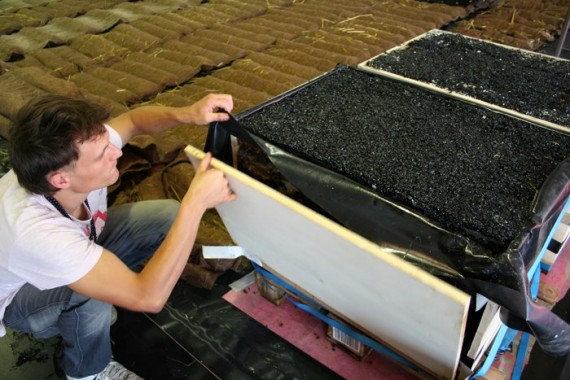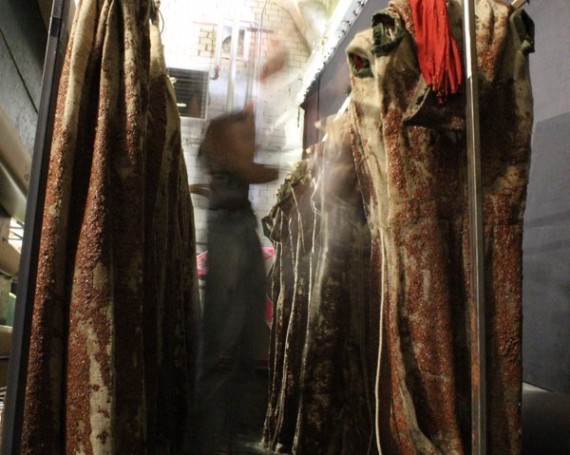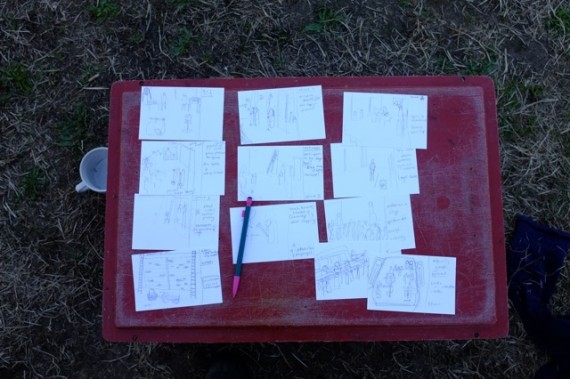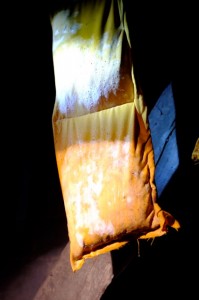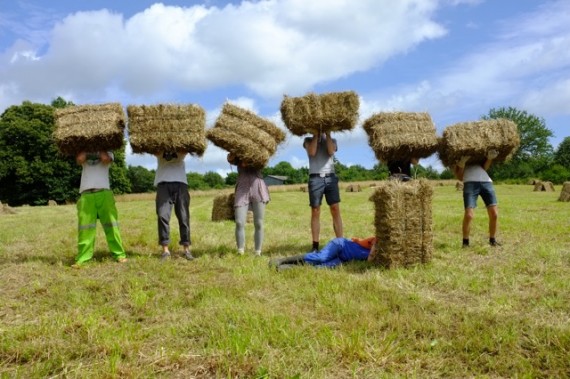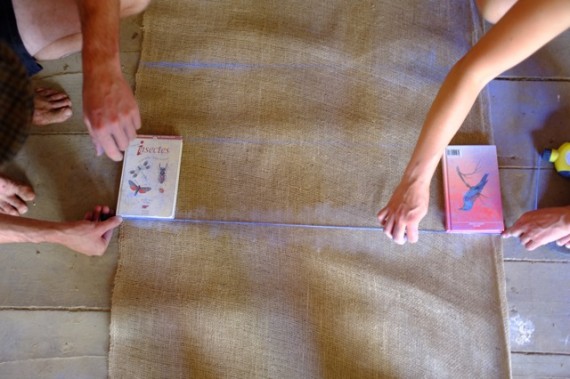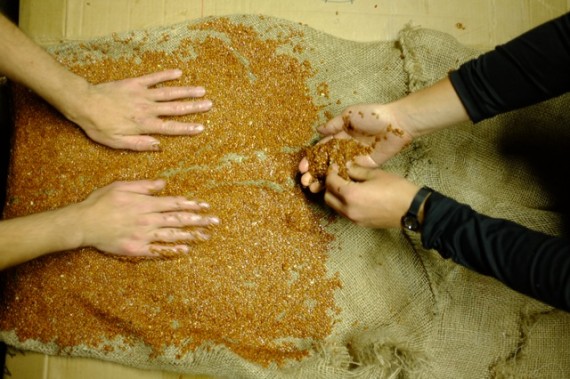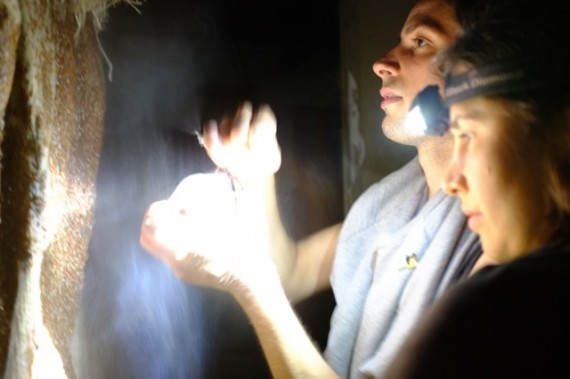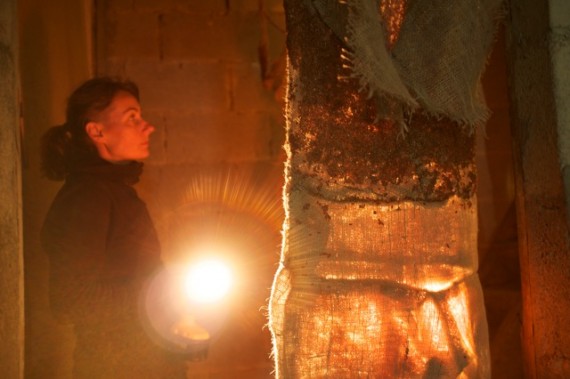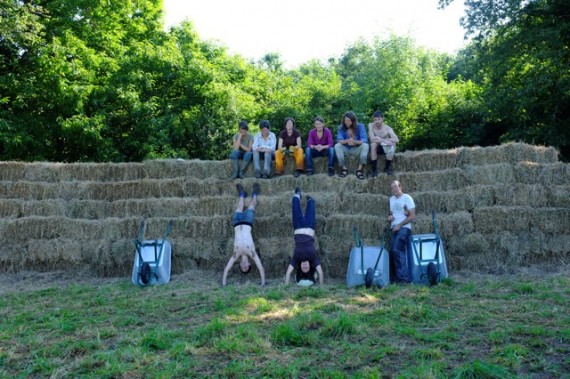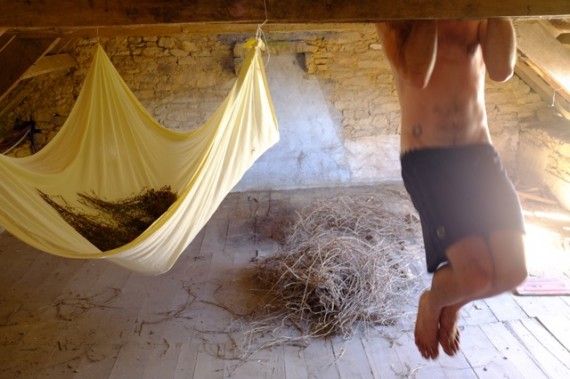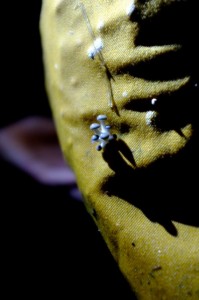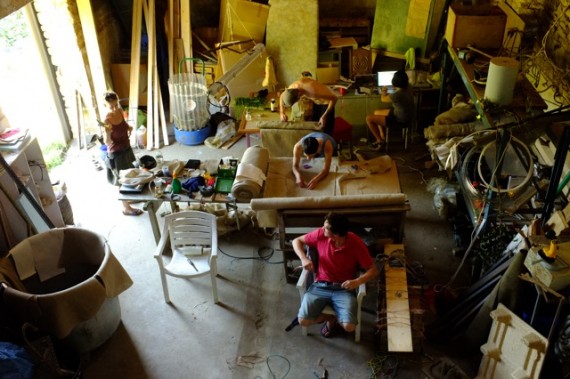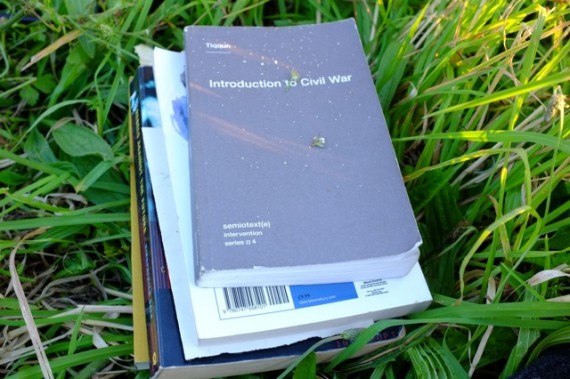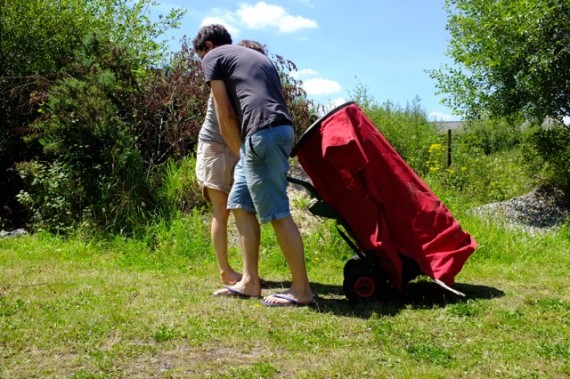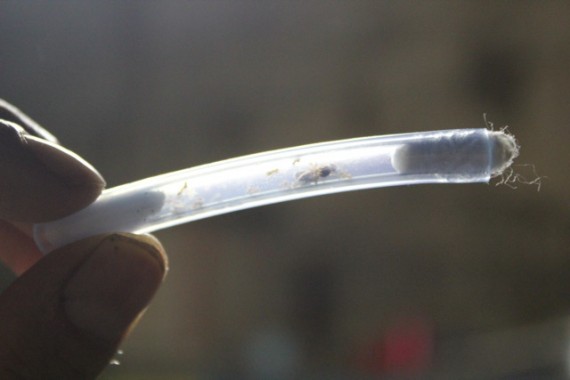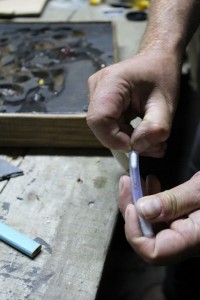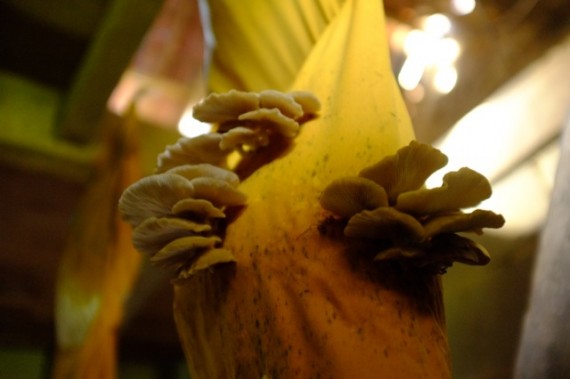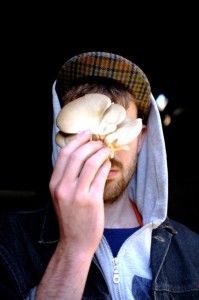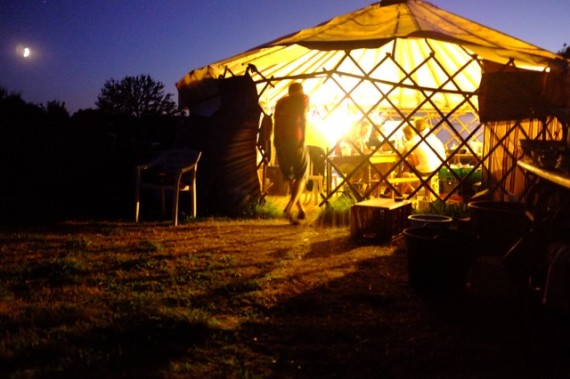Truth is concrete, rebellions are muddy !
16. 11. 2012 // John Jordan // Kategorie Randnotizen 2012It’s nearly 2 months ago that we all sat in rooms in Graz, to talk about and share the worlds that exist between art and activism. Since then I returned to France to our farm preparing for the winter. But the winter was well warmed a month ago, when the french state decicided to evict Europes Largest postcapitalist land occupation, La ZAD, which happens to be 1 hour away from us on the western edges of brittany. Obviously we went there immediately and put our bodies and creativity in the way of the state and their megalomaniac dinosaur dreams of a new airport… We practiced the art of barricade building and the theatre of resistance in a landscape that had a lot more mud than concrete. Below is a blog written about the days of resistance…
Rural Rebels and Useless Airports: La ZAD – Europes largest Postcapitalist land occupation.
October 2012, Notre dames des Landes, France.
Chris leans forward, her long fingers play with the dial of the car radio Im trying to find 107.7 FM a burst of Classical music, a fragment of cheesy pop. Ah! Here we go! I think Ive got it? The plastic pitch of a corporate jingle pierces the speakers: Radio Vinci Autoroute: This is the weather forecast for the west central region happy driving to you all. Traffic info next. Chris smiles.
The narrow winding road is lined with thick hedgerows. Out of the darkness the ghostly outline of an owl cuts across our headlights. We dip down into a wooded valley, the radio signal starts to splinter. The well-spoken female voice fractures into static, words tune in and out and then another kind of sound weaves itself into the airwaves. We rise out of the wood onto a plateau, the rogue signal gets clearer, for a while two disturbingly different voices scramble together the slick manicured predictable sounds of Radio Vinci wrestles with something much more alive, something rawer – a fleshier frequency.
The cops have left the Zone for the night good riddance Yeah! Keep it up everyone! There is a moment of silence, we hear breathing, then a scream into the microphone This is Radio Klaxon Klac Klac Klac! We feel her emotion radiate through the radio waves Its nine thirty five. she laughs and puts a record on, passionate Flamenco guitar pumps into the car.
We have entered La ZAD (Zone A Défendre) Europes largest postcapitalist protest camp a kind of rural occupy on the eastern edge of Brittany, half and hours drive from the city of Nantes. Like a rebel constellation spread across 4000 acres of forest, farmland and marshes, it takes the form of old squatted farms and fields, DIY strawbale houses, upcycled sheds, theatres and bars cobbled from industrial pallets, hobbit like round houses, cute cabins built with the worlds waste, huts perched frighteningly high in trees and a multitude of other disobedient architectural fantasies. La ZAD has been a laboratory for ways of living despite capitalism since the 2009 French Climate Camp. At the camp activists and locals put together a call for people to come and live on the Zone to protect it. Now you can find illegal goat herds and organic bakeries, bike workshops and bee hives, working farms and communal kitchens, a micro brewery, a mobile library, and even a pirate radio station: Radio Klaxon. Emitting from a secret location somewhere in the Zone, the station hijacks the airwaves of Radio Vinci Autoroute the traffic information channel run byVinci for its private network of French motorways. The worlds largest multinational construction firm, builders of nuclear power stations, African uranium mines, oil pipelines, motorways, car parks and the infrastructure of hyper capitalism everywhere, Vinci also happen to be the company commissioned by the French government to cover this landscape in concrete and open Nantes new airport (it already has one) by 2017. Well thats the plan.
The irony of this chequered land of tiny fields framed by miles of rich hedgerows, is that unlike the rest of France, it escaped the regrouping process of the 60s which annihilated the ancient field patterns to open up large tracts of land to industrial agriculture. If the original airport plans, designed to host Concorde, had succeeded this land would have been under tarmac by 1985, luckily it was never built and so the old field patterns remain, as do the faded painted signs that date from the first protests 40 years ago, placed along the side of the road by local farmers declaring: NON A LAEROPORT.
Our car pulls into la vache rit a temporary HQ housed in a giant barn that belongs to one of dozen local farmers who has refused to sell their land to the state. A mural on the façade shows a plane disguised as a bale of hay with an indignant farmer, pitchfork in hand, shouting up at it: you aint going to con us ! Inside the barn, hundreds of people mill around, there are grey haired pensioners, farmers in muddy overalls, a sprinkling of hippies, folk in black hoodies adorned with headtorches and more than a handful of dogs. Food is being cooked and people are browsing the largest free shop Ive ever seen (a space where there is no monetary exchange). Long tables bend under piles of clothes all sorted neatly and signposted: jumpers, trousers, rain jackets, boots (with boxes for different shoe sizes) there is even a box marked dirty socks under one filled with dry ones. Locals from the nearby village of Notre-Dames-des-Landes wash the socks regularly. Another table has mountains of medical supplies whilst the kitchen is drowning in pasta. Supporters from the four corners of France have donated all this material over last week since the evictions began.
On the 16th of October 1200 riot police overran La ZAD. What had been a state free autonomous zone for 3 years was transformed within a few hours into a militarised sector. Road blocks sealed the area, Guard Mobiles (military mobile gendarme units) swarmed everywhere and bulldozers groaned across the fields. Despite resistance from the Zadists within two days the state had destroyed 9 of the 12 of the squatted spaces. On one of the days, 250 rounds of tear gas were fired into the market garden, seemingly to contaminate the vegetables that until that moment had fed over 100 Zadists every week. A principle of war is of course: cut off the supplies.
In the afternoon lorries guarded by convoys of riot vans carried away every sign of habitation - every lump of rubble or shard of broken furniture, smashed crockery or childs toy – everything nothing remained but mud and the scars of bulldozer tracks. This act of erasure was not only to make sure that the wreckage would not be used to rebuild the houses, but more importantly to wipe out all traces of history. Ruins hold memories and stories; and a principle of resistance is that stories stoke struggle.
The movement is finished the local representative of the ministry of interior Patrick Lapouze told the press For two years its been a lawless zone. I cant even go there without police protection and when I go I get stones raining down on my car. Sounding more like a wild west Sheriff than a twenty first century civil servant, he continued: We are going to stop them returning When there are only 150 of them entrenched in a barn, they wont last long! Raising the stakes somewhat he ends his statement: If the République is unable to reclaim this area, then we should be worried for the République. As these words left his lips the images of an elderly woman collecting teargas canisters from a vegetable garden, ancient farmhouses being torn down and farmers pushed around by riot police were circulating across the country and seemed to be touching a nerve.
The airport is the pet project of ex mayor of Nantes, now prime minister – Jean marc Ayrault. Nick named L Ayraultporc (a brilliant play on words merging airport and pig) his ratings had already hit record bottom before all this and now it seems his megalomanic vision, might be a bigger thorn in his side than he ever imagined.
Ayrault has promoted the project as a green airport. It is planned to have living roofs covered in plants, the two runways have been designed to minimise taxiing to save on CO2 emissions and an organic community supported box scheme is meant to feed its employees. Next year Nantes will celebrate its latest award: European Green City 2013. To call this double speak is generous. According to a recent report a hundred million people will die of climate driven deaths over the next eighteen years. 80 percent of the slaughtered will be in countries with lower emissions. The Climate Catastrophe is no just a threat to our ecosystems and the species we share the biosphere with, its a violent war on the poor. A war whose weapons are built out of steel and concrete, tarmac and plastic, a war with a ticking methane bomb hiding under the artic. Waged by the logic of growth and disguised as everyday life according to capitalism, climate change is the war that could end all wars and all life with it. Calling an airport green is as cynical as calling a concentration camp humane. Perhaps in the future if we are lucky t have one, descendents will contemplate the ruins of airports as we do the sites of 18th century slave markets and wonder how a culture could have committed such barbarity so openly.
Im fast asleep in the Cent Chenes (one hundred oaks). For three years people from postcapitalist movements across Europe have made their way here to build alternative lives and lay a new geography over the cartography of capitalism. There is a delicious panoply of new place names, including: La Bellishrut, Pinky, La Saulce, Phar Wezt, No Name, La cabane des filles (the girls cabin) and the mythical Le Sabot (the clog) named for its reference to peasant life as well as the fact that it is the root of the word Sabotage, which literally means to throw your clog into the gears of the machine.
Little do I know, as I dream of police dogs devouring stray cats, that Hurricane Sandy has just hit Haiti and is on its way to New York. Last time I was here in this beautiful strawbale home made entirely from the waste of the world it had a working bakery (supplying man ZADISTS and neighbours with daily organic Bread) and an abundant Permaculture garden. With the threat of expulsion the baker moved his oven to a safer (legal) space nearby and the other inhabitants including Katell, who teaches in the local primary school, took everything of value to the safe house. Now Les Cent Chenes is a ghost of what it was and has been handed over as a collective sleeping space for the activists that have streamed in over the last days, from across the country and abroad, to put their bodies in the way of the evictions. We sleep here to be at hand when the police arrive at the Le Sabot nearby, which is still holding out.
Le Sabot is the market garden now contaminated by CS gas. It was born in the spring of 2011, when over a thousand people armed with spades and seeds coordinated by the international radical young farmers movement Reclaim The Fields, occupied a couple of acres of land in the centre of the Zone and overnight turned it into a functioning vegetable farm. It has its own two-roomed cabin, a polytunnel, solar shower and now a ramshackle penthouse on the roof, to climb onto in case of expulsion. Merging resistance and tangible alternatives, Le Sabot reflects the postcapitalist politics of refusing to separate critique and construction, the yes and the no.
I spend the day with Ishmel an art activist and one of the founders of the French Clown Army. His home La Bellishrut was burnt to the ground last week. How come youre still smiling? I ask as we walk through the dense network of green lanes that joins up the dots of this rebel constellation. I dont care about material things, when we build something we know it wont be forever. We build barricades until sunset. Ishmel has managed to get hold of the old set that the Nantes Opera House were throwing away, it happens to be from an opera about the holocaust. The massive wooden panels make perfectly surreal barricading material.
Since the evictions began the art of building barricades has taken over everyday life here. Everywhere you go there are little teams busy hauling materials across fields to erect another barricade. The idea is to slow the advance of the authorities, who have named their operation Cesar (Caesar), perhaps a reference to Obelix and Asterixs resistant gallic village. The police have taken the weekend off and so barricade building takes place unhindered. Now there are ones rising on the main roads as well as the green lanes. The multiplicity of different barricades reflects the different cultures at La Zad. Those living in tree houses in the Rohanne Forest have asked people not to cut living trees to make them, whilst in another part of the Zone a team of chainsaw wielding activists are tacking down oak trees and tangling steel rope in them. On one crossroads there are at least 20 barricades. There are huge hay rounds with cans of petrol beside them ready to set alight when the police attack, there is a steel wall of sitex Anti squatting panels normally placed on doors and windows of empty houses carefully welded together and one made from dozens of bamboo poles sticking out of the tarmace decorated with bicycle wheels. In the middle of it all there is makeshift kitchen with its mobile pizza oven made from an oil drum.
An affinity group armed with cordless angle grinders and pick axes, have been working day and night to cut out giant trenches in the roads - in some cases several metres wide and deeper than a standing adult. Ishmel tells me that yesterday road agency workers came to mend one of the smaller trenches (not surrounded by barricades). People talked to the workers, trying to persuade them to turn around and not do the dirty work of Vinci. Despite having their boss on the phone coercing them to keep going, they eventually turned around and left the hole in the road. One of the workers later said What troubled me most was that Im from around here and (clearing the barricades to allow the police to circulate) feels a bit like I was helping demolish my neighbours house.There have also been stories of local police officers that refused to join the operation.
The crisp autumn sky swarms with stars. A full moon throws shadows of gnarly oak trees across the fields. We end the evening in Le Sabot, dozens of us sitting around the wood burning Agar to eat a delicious Dauphinoise (a hot pot of potatoes and garlic) garnished with freshly picked Cepp mushrooms. Radio Klaxon plays in the background as always: We have some news: 15 more cop vans have been spotted on the motorway driving in this direction. There are already 30 parked up for the night in the aptly named Disco Paradiso nearby, it seems the second wave of operation Ceasar may well hit tommorow. Laura, who has been on walky-talky all day to coordinate the defence, picks up a piece of chalk and on the blackboard which used to be where the dates for planting and harvesting crops were written up; she scrawls angrily: NON! (NO).
Its 6am. We walk through the thick morning mist. Nebulous silhouettes appear out of nowhere passing us on the lane, people are calmly making their way to the barricades. We carry a small radio, the finger tapping beat of the Latino hip hop group Cypress Hill keeps us awake: When the shit goes down you better be ready! Coffee is served in Le Sabot. Laura is glued to her walky-talky. Gweno, ties his T-shirt around his head to make a DIY balaclava through which you can still see his cheeky smiling eyes. He climbs over the first barricade, in which Ishmel planted bunches of flowers last night and nails a large sign to a tree opposite: Zone of Struggle: Here the people command and the government obeys. Its a phrase from the Zapatista autonomous indigenous communities in Chiapas. Messages of solidarity have been sent from Chiapas and many of the activists here feel a strong link to the masked rebels who since 1994 have built zones free of the state and capitalism in the jungles of southern Mexico. Many of the Zadists also wear masks during actions, to resist being identified by the police, but also perhaps, to be in tune with the spirit of Zapatismo, where a masks both hides you and makes you more visible and where being nobody and yet everybody is a source of freedom.
They are coming! Laura shouts! The cabin empties except for Marie, grey haired and in her sixties, who continues cooking un phased by the news of attack. Through the mist the glint of dozens of riot shields can be seen advancing down the lane towards Le Sabot. Time speeds up: the barricade is set alight, huge flames cut through the dawn light, we hear the sharp crack of tear gas canisters being shot at us, rotten vegetables, paint bombs and stones arc into the sky. I see Gwen running through the field holding one of the shields he has lovingly made: Be careful you are walking on our beatroot, it says on it. For a moment we cant tell what is CS gas and what is morning mist, then our skin begins to scream in pain, Ishmel passes us lemon juice. The boom of concussion grenades being fired several kilometres away thunders across the plateau, Radio Klaxon tells us that they have attacked the forest simultaneously and are trying to take people out of the trees.
It takes several hours for the police to get through the barricades at le Sabot, by the time they arrive in the garden most of us have dissolved into the landscape. A few people remain on the roof of the cabin and Marie continues to cook inside. You will never get rid of us a woman in a pink bandana shouts from the roof we will be back and we will plant even more vegetables!
We hear the sound of the samba band in the distance. We follow the rhythm to try and meet up with it, weaving through fields and hedgerows to avoid the roaming riot police. We pass through a field of high corn, several tractors and a huge harvesting machines are ploughing through it. For a minute the image of normal agricultural life taking place a few hundred metres from burning barricades and flying rubber bullets seems incongruous, but then we see that its Sylvain Fresneau driving the machine. Fresneau is one of the 100 local farmers who are due to be expropriated. He has refused to be bought off by the state. On the lane next to his field there are a thirty tractors flying the Confederation Paysan flag (Independent peasants union) backed up against a line of riot police. The tractors were meant to have reached Le Sabot in solidarity, but got blocked here. It seems however that they have at least managed to allow Fresneau to harvest his silage. For Fresneau to simply do his everyday job on this land is an act of resistance.
We finally meet up with the samba activists. They have marched across the fields to the side of the Zone where bulldozers are clearing barricades off the roads and the relics of rural rioting litter the tarmac. We follow the band into the nearby forest where they play under the tree houses, the police havent got here yet. Like a nimble tree sprite Natasha glides down from her platform. Rolls of rope and jangling karabiners hang from her climbing harness. Someone on the ground below has just picked a mushroom and is wondering what species it is. A professional botanist, Natasha immediately identifies it: its a Russule - super tasty! she declares before climbing gracefully back up into her towering tree.
More than anyone she is aware of how ecosystems are networks of complementary relationships, constantly in the process of becoming more complex and diverse. She understands the unity in diversity that makes up the rich interdependent webs of life within this forest and is horrified by the cultural vacuum that wants to annihilate it. There have been similar cultures, cultures out of touch with their ecologies and sticking to entrenched beliefs. They all wrecked their life support systems and eventually collapsed. Robbing the future to pay the present was the hallmark of every civilisation whose ruins now scatter the deserts.
The government has said they want to cleanse La Zad before November 2012, so that they can begin the archaeological surveys and ecosystems services swaps. By law the headlands of all watershed should be protected and for every wetlands destroyed two have to be created elsewhere. Vinci however, is trying to challenge these laws in court, the verdict will be heard next month. If the ecosystems services project goes ahead it plans to move newts from twelve marshes to a new habitat. Its the twisted logic of capitalism that thinks that you can swap one ecosystem for another, a market mindset where everything has become a commodity – a thing devoid of context. Its the final gasps of a culture that has forgotten that our world is made up of relationships and not things.
The state assumed that by destroying the Zadists houses and gardens they would demoralise the movement. They thought it would collapse when its material base had been removed. But quite the opposite has happened. Our home is not the cob walls and hay bails, the bricks and mortar, says Sara, whose house was raised to the ground last week, but the land and the neighbours and its those connections that have been strengthened during the evictions. Its not just the friendships between activists on the barricades but also the complex relationships between the Zadists, the locals and farmers that have evolved. Its been a roller coaster over the years, Sara continues. There have been strong moments of togetherness but many of mutual misunderstanding and mistrust. There are some huge ideological differences between us the squatters and the folk at ACIPA (The anti-airport NGO made up of local farmers and residents) but since the evictions, new levels of mutual aid and support have emerged that were once thought impossible. Not only did Sylvain Frenaus open his barn as an HQ for everybody, but the ACIPA has set up a daily meeting point to bring newcomers into the Zone to resist the evictions, farmers and locals have stood as human shields between the masked activists and the riot police, whilst other have helped build barricades with their tractors and loaned out chain saws. The French state and media has tried undermine exactly this kind of sharing and support over the years by labelling the squatters as members of the Ultragauche (the ultra leftists).
A mythical term invented by a neurotic government Les Utragauche has been used to criminalise anticapitalist antiauthoritarian movements and throw the shadow of terrorism on to anyone influenced by the so called: insurrectionist sect that wrote the now infamous, and according to right wing U.S TV anchor Glen Beck evil book - The Coming Insurrection. The term is a weapon of repression used to divide the good protesters from the bad and to prevent diverse movements arising. What the government cant control is a movement where farmers ploughing and planting monocultures are rebelling side by side with Permaculturists who practice no dig gardening, where older trade unionists sit in meetings with young anarchists who demand an identity beyond work, where libertarian communists teach pensioners how to forage wild foods and Anti civilisation vegans are lent tools by dairy farmers. It is the dynamic diversity of ecosystems which keeps them strong and resilient to shocks, movements that find unity in diversity are much harder to destroy than houses and forests and the new socialist government knows this.
Its been three weeks since the evictions began, Le Sabot and Les Cent Chenes have been razed as have many of the other spaces. Two squatted farmhouses are still waiting for eviction papers whilst every time the police tear down the barricades around the Phar Wezt they pop up again like mushrooms – as I write, its tree houses and huge communal kitchen remain intact and people are already rebuilding in hidden nooks and crannies of the Zone. Thanks to the pressure on the government from hunger striking farmers last summer, locals who have refused to sell cannot be evicted until all legal recourses have been exhausted. The trial around the destruction of wetlands is due to end in December.
In many struggles, the moment of eviction tends to be the last great cry after which the movement fades. But quite the opposite has occurred, something in the fight to save La ZAD has resonated with people. The last three weeks have completely transformed this struggle from a relatively local debate into an issue of national importance. Everyone on the ground expected the media to run images of masked youth throwing molotovs (3 in all were thrown!) and to play the Ultragauche card which would have scared people away and opened the door to harsher police repression. But this did not happen and instead solidarity began to flow and flow. Support groups sprung up in cities and villages across France. Meetings, demonstrations and actions erupted from Toulouse to Strasbourg, Brussels to Besançon: Graffiti and banners appeared on dozens of motorway bridges, a clown army invaded the offices of Vinci, thousands marched in Rennes, Nantes and Paris, a go slow blocked commuter traffic into Nantes, Vinci car parks were occupied and made free for motorists, the studios of a national radio programme were invaded and statement read on air, a street theatre pieces married Vinci and the state and the windows of several socialist party HQs were smashed.
Front pages in the regional and then the national press including Le Monde, began to talk about La ZAD as the new Larzac. Beginning in the 1970s the Larzac was a rural area of Southern France where a mass movement brought farmers and activists together against the expansion of a military base. It is seen as an iconic struggle not only due to it linking radically different cultures but also because it won. In 1981 the recently elected socialist president François Mitterrand cancelled the project. To name La ZAD as new Larzac is like a little known rock band being touted as the new Lady Gaga!
The discourse has expanded too. Many now see the choice to build an airport as yet another symptom of a system totally out of touch with reality. Its a choice from another age, an age where climate change and peak oil were not yet threats, an age where the ideology of infinite growth was all that defined progress, an age where people talked about economic crisis rather than the economy as crisis. It seems that what is touching people is the destruction of ways of life that refuse to be part of such an antiquated society. It is the farmers firm stand, risking everything so that they can continue to produce food from their land that moves us. It is the Zadists simple lives, lived according to their passions and their needs that gives us glimpses of the future in the present. These things make so much more sense than a new airport built for political ego, corporations and profits. And now the story is no longer just about an airport, but about making the choice to oil the suicide machine wrecking our future or becoming its counter friction and opening new visions of what it means to live.
A year ago, the Zadists put out a call for a day of Reoccupation to take place four weekends following the anticipated evictions. They asked people to come with hammers, planks and pitchforks, to reoccupy the land and build. When they wrote the text little did they realise that the evictions would have transformed La ZAD into a household name. The date has been set for the 17th of November. Every Tuesday for the past three weeks 150 people have packed out a hall in Nantes to plan the reoccupation. There are groups of local architects and carpenters busy designing a meeting house; mass catering kitchens from across Europe are preparing food for thousands; 200 tractors are being mobilised; farmers, artists and activists from the Morbihan are planning a toilet and shower bloc complete with cacapult; a kit house is due to be brought 800 km from Dijon and there are even rumours that someone wants to build a special tower in the field where the control tower is planned.
How many people will turn up on the 17th of November no one knows, how many homes and farms will be rebuilt remains a mystery, but what is clear is that this movement is far from being finished, in many ways its has just begun.
For more info: Zad.nadir.org

























